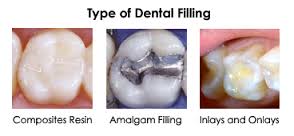Dental Fillings is a type of restorations on teeth that is used to repair teeth that have fractures or tooth decay. There are many types of dental restorations, the most common are resin composite, amalgams, or porcelain fillings. Like all type of restorations there are pros and cons. The procedure is very common, first the dentist administers anesthetic on the site where the tooth will be worked on, and then the dentist will prep the tooth removing all decay, after the tooth is prep the dentist will then decide what type of dental fillings will be used. After the fill is placed the dentist will check your occlusion to make sure it’s even. The type of dental restoration that the dentist will use is based on what is best for you.
Dental amalgam or silver fillings are made of metal and are used on large restorations. They produce less sensitivity for these cases, and are also the less expensive. This type of restoration usually lasts up to 15 years. Silver fillings will usually be used in molars or premolars (back teeth) they are very noticeable and are not used in visible areas. Silver fillings are being used less, due to patients not wanting metal or grey or silver fillings in their mouth. Amalgam fills also causes discoloration on the surrounding tooth structure were placed.
Composite fillings are made of a resin. This type of restoration is the most popular because it matches the tooth color. Composite fillings are ideal on small restorations or anterior (front teeth). In most cases people don’t know you have restorations. The preparation for resin fillings require to remove less tooth structure. Composite fillings are not recommend for large restorations, patients are expected to feel sensitivity for a couple days sometimes weeks. Composite fillings can stain and need to be replaced more often than the amalgam filling.
There can be many types of porcelain restorations. Crown, bridges, veneers, onlays, inlays are some examples. Porcelain fillings just include onlays and inlays. Inlays replace the chewing surface of a tooth, and onlays can replace chewing surface and the cusps. When your dentists prepares the tooth for an onlay or inlay they remove all decay and remove more tooth structure for the onlay or inlay to fit. Onlays and inlays are fabricated in the lab to fit the preparation site of your tooth. This type of porcelain filling can last up to 30 years. The cost is more expensive that a traditional composite or amalgam fill.
With any type of dental fillings there can be some sensitivity issue, this usually last a couple days and tends to go away. You shouldn’t experience any pain from your tooth after dental fillings. If you do experience any pain and it doesn’t go away it’s usually that the nerve is affected. You should return to your treating dentists to double check the filling. The way to maintain your new filling no matter the type of restoration is by brushing and flossing. This will remove any plaque and stop recurrent decay. It’s always a good idea to have your regular check up’s and cleanings.


